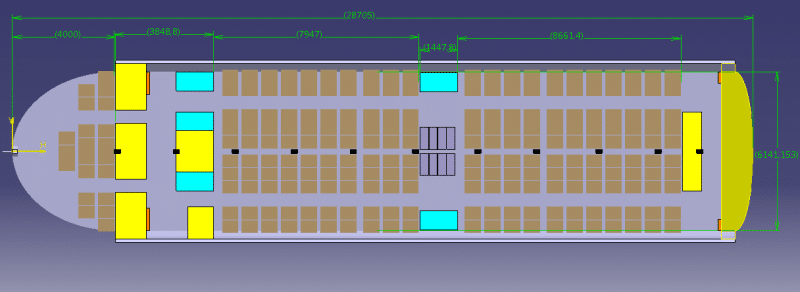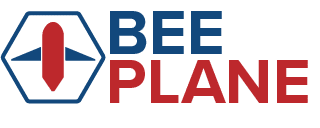Bee-Plane Passenger Floor Plan
It represents passengers cabin layout with seats, aisles, toilets, galleys, structures, luggage’s area.
Passenger floor that have been studied :
- For TRL2, 2014
Tripple pressure bubble, two aisles of reinforcement structures, two aisles, central exit doors, galley in the middle en back. 220 passengers.
One single main door on each side for passenger’s embarkation. Main galley is on the back.
Doors are in the middle of the basket, bellow wings. Wall of the luggage’s area is used as reinforcement structures.
- TRL1 Estaca 5A, 2013
Double pressure bubble, single reinforcement structures, two aisles, front and rear exit doors, galley in the middle.



As we continue to refine and advance the Bee-Plane design, the passenger experience remains at the forefront of our development goals. The evolution from TRL1 to TRL2 has seen significant enhancements in cabin layout and structural design, offering a more comfortable, safe, and enjoyable journey for all passengers. Our focus on improving the passenger environment reflects our commitment to not only meeting but exceeding current aviation standards and passenger expectations.
Looking ahead to TRL3, Bee-Plane is set to introduce even more revolutionary features aimed at enhancing passenger comfort and operational efficiency. Plans include the implementation of advanced climate control systems, state-of-the-art entertainment options, and increased personal space for each passenger. Furthermore, the introduction of innovative materials and smarter cabin designs will optimize the overall weight and durability of the aircraft, contributing to reduced carbon emissions and increased sustainability.
The ongoing development of the Bee-Plane is a testament to Technoplane’s dedication to pushing the boundaries of what is possible in modern aviation. By incorporating feedback from our collaborative network and staying abreast of new technological advancements, we ensure that each iteration of the Bee-Plane is better than the last. We invite industry partners, regulators, and the flying public to join us as we continue to innovate and refine our designs, aiming to revolutionize air travel for a safer, more efficient, and more enjoyable future.
Stay tuned to BeePlane.com for updates on our progress, insights into our design process, and opportunities to get involved in the future of aviation. Together, we are flying towards a new horizon.
Bee-Plane Passenger Floor Plan: Innovating Aircraft Interior Configurations
Introduction
As Bee-Plane progresses from TRL1 to TRL2, the emphasis on optimizing passenger experience is evident in the design of its passenger floor plan.
The project focuses on unique configurations aimed at maximizing space utilization, passenger comfort, and overall operational efficiency.
Below, we delve into the specific configurations studied for TRL2 in 2014 and TRL1 in 2013.
TRL2 Configuration: A Deep Dive into 2014 Designs
Floor Plan Features:
- Triple Pressure Bubble: A cutting-edge feature aimed at improving cabin pressure stabilization.
- Two Aisles of Reinforcement Structures: Ensures the structural integrity of the plane while providing two separate aisles for passengers to move freely.
- Central Exit Doors: Located in the middle for efficient embarkation and disembarkation.
- Galley Locations: Situated in the middle and back, optimized for in-flight service distribution.
- Passenger Capacity: Designed to accommodate up to 220 passengers.
- Single Main Door: One primary entry and exit point on each side, designed to streamline boarding procedures.
- Luggage Area Reinforcement: The walls of the luggage area double as reinforcement structures, serving a dual purpose.
Design Implications:
The triple pressure bubble configuration is a pioneering feature in modern aeronautics, geared towards enhanced comfort through cabin pressure stabilization.
The two aisles of reinforcement structures not only offer structural rigidity but also contribute to the passenger’s freedom of movement.
TRL1 Configuration: Estaca 5A, 2013
Floor Plan Features:
- Double Pressure Bubble: A precursor to the triple pressure bubble, aiming for efficient pressure management inside the cabin.
- Single Reinforcement Structure: A more traditional approach focused on the core structural integrity of the aircraft.
- Front and Rear Exit Doors: Strategically placed for quicker and easier boarding and deboarding.
- Central Galley: Optimized for balanced and efficient service to all passengers.
Design Implications:
The TRL1 design appears more conventional when compared to TRL2 but introduces the innovative double pressure bubble feature.
The single reinforcement structure indicates a simpler yet effective design.
Comparative Analysis
- Efficiency: TRL2, with its triple pressure bubble and multiple reinforcement structures, is evidently aiming for more efficient space utilization and passenger comfort.
- Capacity: TRL2 accommodates more passengers, thereby potentially offering better per-seat operational costs.
- Flexibility: The more complex TRL2 design might offer greater flexibility in terms of modifications and future upgrades.
- Ease of Operations: The simpler TRL1 design might have the edge in easier operational handling, from both the flight crew and maintenance perspectives.
Conclusion
Bee-Plane’s passenger floor plans reflect a thoughtful approach to marrying technological innovation with passenger comfort and operational efficiency.
As the project continues to evolve, these floor plans offer a compelling glimpse into what could very well be the future of aviation design.
For more details, the project documentation and images are available for public review. Feel free to visit the official Bee-Plane website for more information.
Disclaimer: All the images and project documents are the property of their respective owners and are used here for informational purposes.
